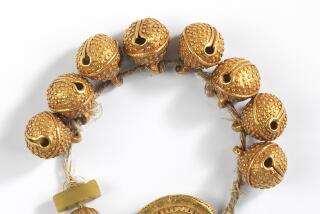Something Old, Something Blue : After More Than 200 Years Under the Sea, a Cache of Chinese Porcelain and Gold Comes to Market
- Share via
Most people, on being told that valuable treasure has been recovered from a European ship that was wrecked in the South China Sea about 1750, might assume that the cargo was precious metals and gems.
To an extent, they would be right. Part of the salvaged cargo, which Christie’s is offering for sale in Amsterdam (April 28 through May 2), is a gleaming pile of gold bullion. The gold bars are Chinese. Some are “Nanking shoes,” modeled on sycees , the slippers worn by women in ancient China. Other bars, rectangular, are stamped with the phrase yuan ji bao , which turns out to mean, rather boringly, “gold ingot.”
But the extraordinary part of the rescued cargo is more than 100,000 pieces of Chinese porcelain, any one of which would be regarded as a collector’s piece. The Amsterdam sale is a chance to buy “new” 18th-Century wares. It is as though a Chippendale cabinet had been discovered in some musty back room in London, wrapped in chamois and in its original packing case. The Chinese porcelain is mostly decorated in underglaze blue; the blue decoration, depicting scholars, landscapes, flowers and fishermen in small boats, has been protected from the ravages of salt water by its coating of transparent glaze. The porcelain was packed in cases and padded with tea, which also would have been sold in the port of destination.
What that port was, nobody is quite sure. The ship was on its return journey from Canton (now Hwangchow) to its port of origin, probably in England, Holland or Scandinavia. The recovery was made by Capt. Michael Hatcher, a British-born salvage expert based in the Far East. This is not Hatcher’s first haul of antique porcelain. In 1983, while engaged in salvaging merchant ships sunk during World War II, he accidentally found the wreck of an Asian junk containing thousands of pieces of Ming and other mid-17th-Century Chinese porcelain. That cargo was sold at Christie’s in Amsterdam in 1984, for $2.2 million. Fired by that success, Hatcher concentrated on searching for ancient vessels. There was gold in them there crocks.
One question that the latest discovery and the forthcoming sale raise is this: Will not the sudden influx onto the market of so many mid-18th-Century specimens of the blue-and-white china cause a sharp devaluation of such pieces? The sale contains, for example, no fewer than 509 chamber pots. In the past, a Chinese blue-and-white chamber pot, while not something that one would necessarily display on the mantelpiece, was a rarity. In the future, a proud owner will be aware that there are at least 508 almost identical vessels floating around the world. There are also huge dinner services, with settings for as many as 144 guests. The services vary in size from more than 370 pieces down to settings for six; they include tureens, saltcellars, covered condiment pots, meat dishes and dinner and soup plates. The cargo also contains more than 40,000 tea bowls and saucers, painted with about 20 patterns.
The last big upset in the art world came when the J. Paul Getty Museum suddenly had too many millions to spend. Christie’s Amsterdam sale suggests the opposite problem, of too many antiques to buy--an embarras de richesses that is bound to cause some turbulence in prices. But as Colin Sheaf, a departmental director at Christie’s, London, points out in his introduction to the lavish sale catalogue, the auction will be “a chance for very many purchasers to buy, at extremely reasonable prices . . . a single dinner service, a set of plates, a few amusingly shaped table vessels, or a tea service--usable and attractive domestic table wares which import an element of Eastern richness to a European tea-table or a candlelighted dining room.”
One item recovered from the wrecked ship will not be sold: the ship’s bronze bell, with an inscription that shows it was made by C. C. Jansz, a Dutchman, in 1747. Hatcher believes that “no other object recovered from the ship is so significant for the maritime history of the Netherlands” and has ensured that the bell will remain in Holland, by presenting it through the Ministry of Culture for permanent display in an appropriate Dutch public collection.
More to Read
Sign up for The Wild
We’ll help you find the best places to hike, bike and run, as well as the perfect silent spots for meditation and yoga.
You may occasionally receive promotional content from the Los Angeles Times.






